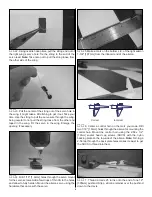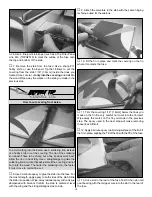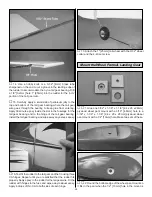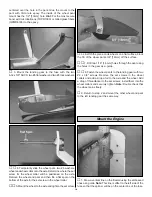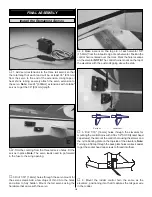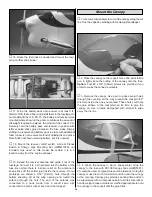
❏
6. Use a fine-point felt-tip pen such as a Top Flite
®
Panel
Line Pen (TOPQ2510) to mark the outline of the fuse onto
the top and bottom of the stab.
❏
7. Remove the stab from the fuse. Use a sharp #11
hobby knife or use the Expert Tip that follows to cut the
covering from the stab 1/16" (1.6mm) inside the lines you
marked. Use care to cut only into the covering and not into
the wood. Wipe away the marks on the stab you made in the
previous step.
How to cut covering from balsa.
To avoid cutting into the balsa, use a soldering iron instead
of a hobby knife to cut the covering. The tip of the soldering
iron doesn't have to be sharp, but a fine tip does work best.
Allow the iron to heat fully. Use a straightedge to guide the
soldering iron at a rate that will just melt the covering and not
burn into the wood. The hotter the soldering iron, the faster
it must move to melt a fine cut.
❏
8. Use 30-minute epoxy to glue the stab into the fuse. For
the most strength, apply epoxy to both sides of the stab. Slide
the stab into position. Wipe away residual epoxy with a tissue
dampened with alcohol. Confirm the stab is centered, level
with the wing and the string still aligns side to side.
❏
9. Attach the elevators to the stab with the same hinging
technique used for the ailerons.
❏
10. Fit the fin in place and mark the covering on the fin
where it contacts the fuse.
❏
11. Trim the covering 1/16" [1.6mm] below the lines you
made on the fin. Be very careful not to cut into the fin itself.
Wipe away the marks on the fin you made in the previous
step. The epoxy used in the next step will make removing
those lines difficult.
❏
12. Apply 6-minute epoxy to all joining surfaces of the fin. Fit
the fin in place, aligning the TE of the fin with the TE of the fuse.
❏
13. Cut a slot in the rear of the fuse. Test fit the nylon tail
gear bearing with the tail gear wire into the slot in the rear of
the fuse.
12









